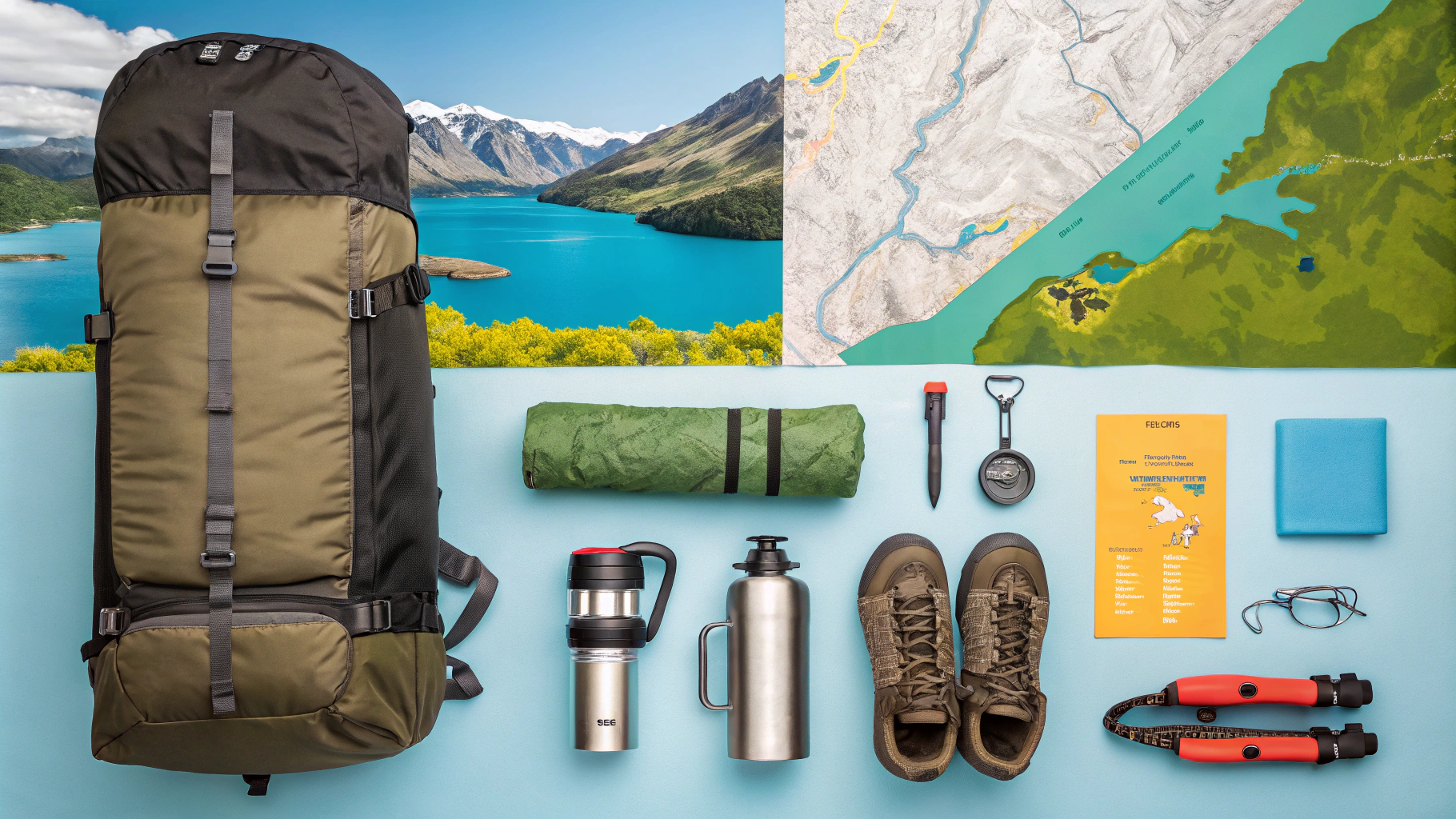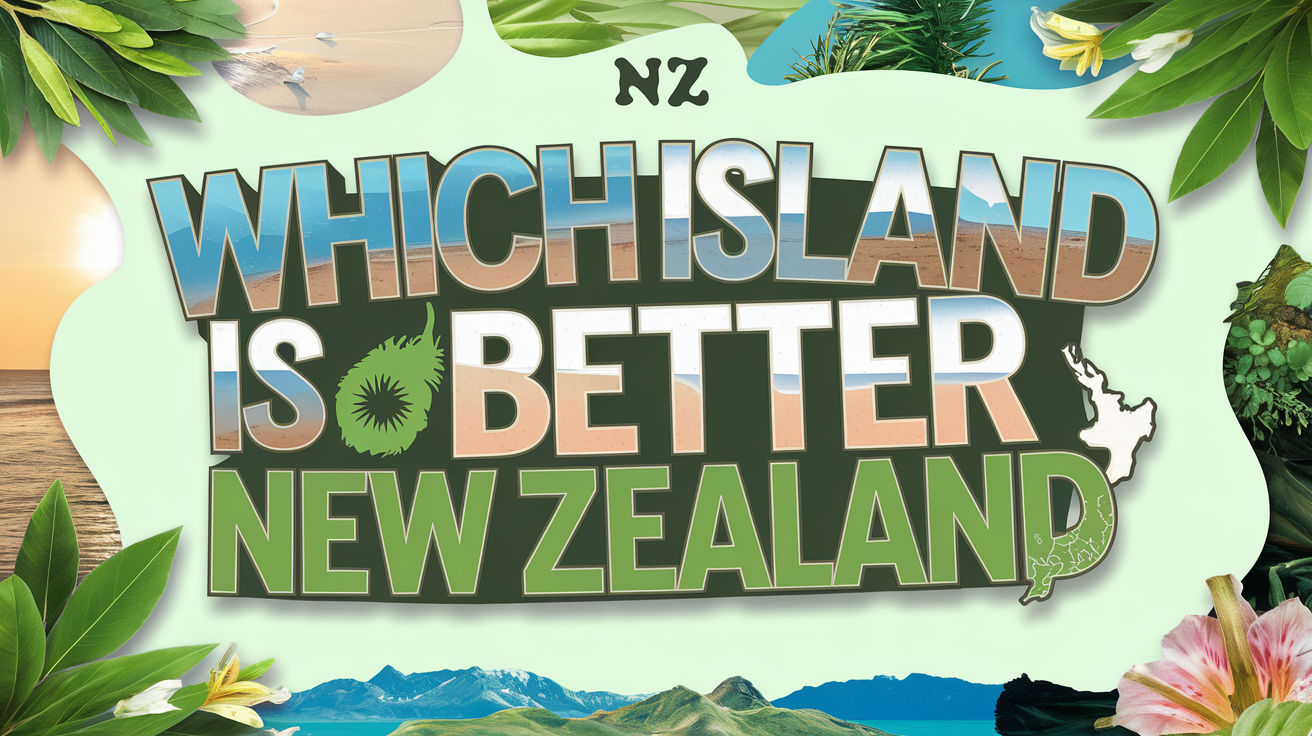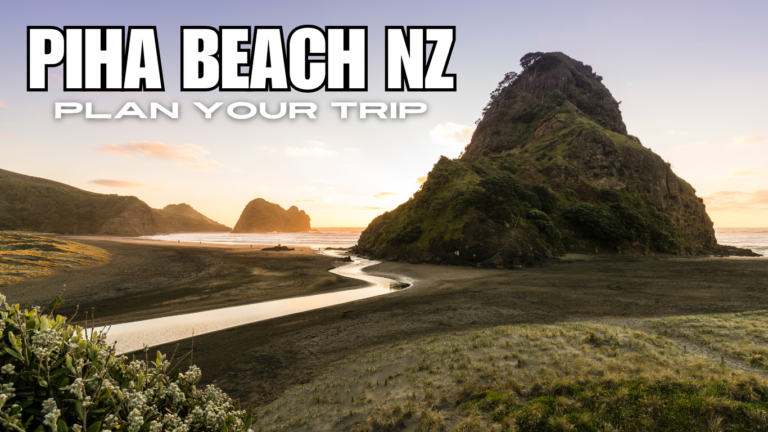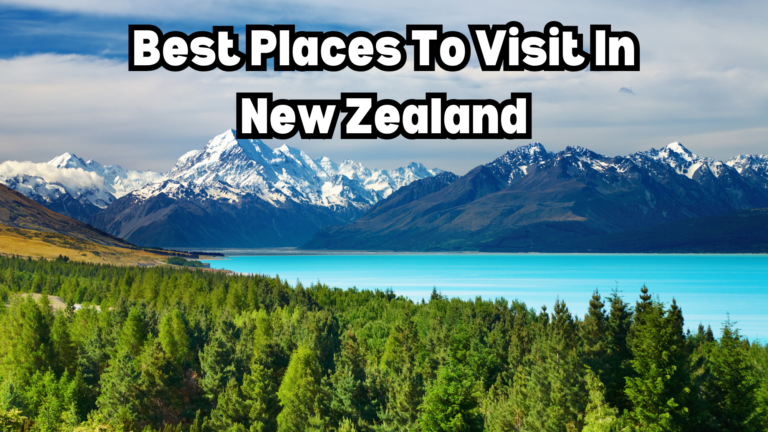Backpacking Gear List for New Zealand Travel
For backpacking in New Zealand, you’ll need a versatile gear list to handle diverse conditions. Pack a lightweight tent, warm sleeping bag, and insulating pad for shelter. Layer your clothing with merino wool base layers, fleece mid-layers, and waterproof outer shells. Don’t forget navigation tools like maps and a compass, plus safety equipment including a first aid kit and headlamp. Bring a compact cooking setup, non-perishable food, and water purification methods. Include personal hygiene essentials and electronics like a power bank and camera. With the right gear, you’ll be prepared for New Zealand’s varied landscapes and unpredictable weather. Discover more about each essential category to fine-tune your packing list.
Key Takeaways
- Pack a 2-person tent (1.5-2.5 kg) and sleeping bag rated for -5°C to 0°C (0.8-1.2 kg) for New Zealand’s varied climate.
- Bring merino wool base layers (120-200g/m²) for temperature regulation and odor resistance in diverse weather conditions.
- Include waterproof outer shells with Gore-Tex or similar technology for protection against New Zealand’s unpredictable weather.
- Carry a reliable navigation system, including topographic maps, compass, and GPS device with spare batteries.
- Pack lightweight cooking equipment like titanium pots and a compact stove, along with non-perishable food options and water purification methods.
Essential Shelter and Sleeping Gear
When backpacking in New Zealand, your shelter and sleeping gear are essential for comfort and safety. Start with a 2-person tent, which offers ample space for you and your gear.
These tents typically weigh between 1.5-2.5 kg, striking a balance between comfort and portability.
For sleeping, choose a bag rated for -5°C to 0°C to handle New Zealand’s varied temperatures. These bags usually weigh 0.8-1.2 kg. Pair it with an inflatable sleeping pad for insulation and comfort.
Look for a pad weighing 0.3-0.6 kg with an R-value of at least 2 for warm weather or 5+ for winter trips.
Don’t forget a sleeping bag liner. It adds 2-5°C of warmth and keeps your bag clean, weighing only 0.1-0.3 kg. This small addition can greatly enhance your comfort during chilly nights.
When selecting your pad, prioritize the R-value. A higher value indicates better insulation, imperative for maintaining warmth on cold ground. By carefully choosing these essential items, you’ll guarantee restful nights and energized days throughout your New Zealand backpacking adventure.
Weather-Appropriate Clothing Layers
When backpacking in New Zealand, you’ll need to pack versatile clothing layers to handle the country’s changeable weather.
Start with merino wool base layers for temperature regulation and moisture-wicking, then add insulating mid-layers like lightweight fleece or synthetic jackets for warmth.
Base Layer Essentials
The foundation of your New Zealand backpacking wardrobe starts with high-quality merino wool base layers. These versatile garments are essential for regulating your body temperature across the country’s varied climate.
During warmer months (December to February), opt for lightweight merino tops to keep you comfortable in temperatures ranging from 10°C to 25°C. For colder seasons, especially in mountainous regions where temperatures can plummet to -10°C, thermal merino layers are vital for insulation.
When selecting your merino base layers, prioritize fabrics with at least 80% merino wool content and a weight between 120g/m² and 200g/m². This composition guarantees peak performance, offering:
- Excellent breathability
- Effective moisture-wicking properties
- Natural odor resistance
- Superior temperature regulation
The odor-resistant quality of merino wool is particularly advantageous for backpackers, as it reduces the need for frequent washing and helps minimize pack weight. By investing in high-quality merino base layers, you’ll be well-equipped to tackle New Zealand’s diverse landscapes and weather conditions, guaranteeing comfort and adaptability throughout your backpacking adventure.
Insulating Mid-Layers
Building upon your merino base layers, insulating mid-layers play a key role in your New Zealand backpacking gear. Opt for lightweight fleece jackets or pullovers weighing between 200-300 grams to achieve ideal warmth and breathability.
These mid-layers should keep you comfortable in temperatures ranging from 5-15°C (41-59°F) and can be layered under a waterproof outer shell for added protection.
Consider synthetic insulations like Polarguard or Polarguard 3D, which retain warmth even when wet and dry quickly. When selecting your mid-layer, factor in your activity level and expected weather conditions.
Choose breathable, moisture-wicking fabrics such as merino wool or synthetic materials to regulate your body temperature effectively.
Two highly recommended options for New Zealand backpacking are the Rab Microlight Jacket and the Patagonia R1 Pullover. These pieces strike an excellent balance between warmth, weight, and breathability.
Waterproof Outer Shells
Three critical components make up a reliable waterproof outer shell for New Zealand backpacking: a waterproof and breathable membrane, adjustable features, and durable water repellent (DWR) coating.
When selecting your outer shell, opt for a 2-layer or 2.5-layer construction, which balances weight, breathability, and durability. Look for jackets with Gore-Tex, eVent, or similar technologies to guarantee water resistance and breathability.
To maximize protection against New Zealand’s unpredictable weather, choose a jacket with:
- Adjustable cuffs to prevent water from entering your sleeves
- A cinchable hem to keep your core dry
- An adjustable hood to shield your face from rain and wind
- Water-repellent treatment on the fabric’s exterior
Popular brands like The North Face, Patagonia, and Columbia offer a range of options to suit various needs and budgets.
Remember, your outer shell is essential for protecting against rain and wind, so invest in a quality piece that’ll keep you dry and comfortable throughout your backpacking adventures.
Navigation and Safety Equipment
When venturing into New Zealand’s diverse landscapes, reliable orientation and safety equipment are essential for any backpacker. Start with a detailed topographic map of the area you’ll be exploring and a reliable compass.
GPS devices are valuable, but don’t rely solely on them; always carry spare batteries.
Pack a personal locator beacon (PLB) for emergencies in remote areas. It’s a lifesaver if you’re injured or lost.
Include a basic first aid kit with essentials like bandages, antiseptic wipes, pain relievers, and any personal medications.
A sturdy, waterproof headlamp with extra batteries is vital for traversing in low light conditions.
Carry a whistle for signaling in emergencies and a small mirror for attracting attention if needed.
Don’t forget sun protection: high-SPF sunscreen, sunglasses, and a wide-brimmed hat are must-haves in New Zealand’s intense UV environment.
Pack insect repellent to ward off sandflies and mosquitoes.
Lastly, always inform someone of your planned route and expected return time.
Consider renting a satellite phone or messaging device for extended backcountry trips to maintain communication in areas without cell coverage.
Cooking and Food Supplies
When packing for your New Zealand backpacking adventure, you’ll need lightweight cooking equipment, such as titanium pots and pans, to keep your pack manageable.
Stock up on non-perishable food options and use odour-proof bags to protect your supplies from local wildlife.
Don’t forget to include water purification methods like filters or boiling equipment, ensuring you’ll have safe drinking water throughout your journey.
Lightweight Cooking Equipment
Efficiency is key when it comes to lightweight cooking equipment for your New Zealand backpacking adventure.
You’ll want to pack gear that’s compact, durable, and won’t weigh you down on the trail.
The MSR Pocket Rocket 2 stove is an excellent choice, weighing just 73 grams and fitting in the palm of your hand.
Pair it with a Snow Peak titanium cup and spoon, which together weigh only 158 grams, for a minimalist cooking setup.
Don’t forget to include a versatile Opinel knife for food preparation.
With a weight of 50 grams and an 8.5 cm blade, it’s perfect for slicing and dicing on the go.
To keep your food fresh and protected from the elements and wildlife, pack lightweight, airtight containers made of silicone or nylon.
For a complete lightweight cooking kit, consider including these essential items:
- MSR Pocket Rocket 2 stove (73g)
- Snow Peak titanium cup (132g) and spoon (26g)
- Opinel knife (50g)
- Lightweight water bottle or hydration bladder (100-200g)
Remember to purify your water using a filter or by boiling to guarantee safe drinking water throughout your New Zealand backpacking trip.
Non-Perishable Food Options
Sustenance is essential for any backpacking adventure, and non-perishable food options are your best bet for New Zealand’s trails. When packing, prioritize lightweight, energy-dense foods that won’t spoil quickly.
Freeze-dried meals, energy bars, and instant soups are excellent choices for their convenience and weight efficiency.
For snacks, consider packing jerky, dried fruits, and nuts. These options are calorie-rich and easy to store, providing quick energy boosts during your hikes.
To create varied meals, bring instant noodles, lentils, and dried vegetables. These compact ingredients can be combined in different ways to keep your meals interesting.
Don’t forget to pack powdered milk, instant coffee, and tea bags for warm, comforting beverages. These small luxuries can make a big difference in your overall backpacking experience.
While canned goods like tuna, beans, and chicken offer protein, be mindful of their weight and bulk.
If you choose to bring them, limit the quantity and opt for smaller cans. Remember, the key to successful backpacking is balancing nutrition with pack weight, so choose your non-perishable food options wisely.
Water Purification Methods
With New Zealand’s pristine wilderness comes the responsibility of ensuring safe drinking water. While many areas offer clean water sources, it’s essential to be prepared for all scenarios.
You’ll need reliable water purification methods to stay hydrated and healthy during your backpacking adventure.
Consider these effective water purification options for your New Zealand trek:
- Water filter pump: A compact, hand-operated filter that removes bacteria, protozoa, and sediment from water sources.
- UV light purifier: A battery-powered device that uses ultraviolet light to neutralize harmful microorganisms in clear water.
- Chemical tablets: Lightweight and easy-to-use tablets that kill waterborne pathogens but may affect taste.
- Boiling: A foolproof method that requires a portable stove and fuel, effective against all waterborne threats.
Choose the method that best suits your needs, considering factors like weight, ease of use, and treatment time.
Remember to research the water quality in your specific hiking areas, as some regions may have naturally occurring contaminants that require specialized filtration. Always carry a backup purification method and enough water to reach your next reliable source.
Water Management Systems
Water management is crucial for any backpacking trip in New Zealand’s diverse landscapes. You’ll need a thorough system to guarantee you’re never caught without this essential resource.
Start with a reliable hydration bladder, typically 2-3 liters in capacity, which fits comfortably in your backpack and allows for easy drinking on the go. Complement this with one or two durable water bottles, preferably made of BPA-free plastic or stainless steel.
For longer treks, consider a collapsible water container that can hold 4-10 liters. This will come in handy when camping in areas with limited water sources.
Don’t forget to pack a few water filtration bags or lightweight stuff sacks to collect and transport water from streams or lakes to your campsite.
To maximize efficiency, invest in a quick-connect system that allows you to easily transfer water between your various containers and filtration devices.
This setup will save you time and effort during water collection and purification processes.
Personal Hygiene Essentials
Maintaining personal hygiene is essential for a comfortable and healthy backpacking experience in New Zealand.
Your personal hygiene kit should include a mini first aid kit with painkillers, anti-diarrheal medication, antihistamine, leukotape, and chafing prevention.
Don’t forget toiletries like sunscreen (SPF 30+), lip balm with SPF, and insect repellent containing DEET, picaridin, or oil of lemon eucalyptus.
For waste management, pack toilet paper and a small trowel to dig catholes and bury waste.
A fast-drying travel towel is vital for drying off after showers or swims.
Hand sanitizer or biodegradable soap will help you keep clean when water is scarce.
Women should pack feminine hygiene products in airtight containers.
To guarantee you’re fully prepared, here’s a quick checklist of personal hygiene essentials:
- Mini first aid kit with medications
- Sun protection and insect repellent
- Toilet paper, trowel, and hand sanitizer
- Fast-drying towel and feminine hygiene products (if applicable)
Electronics and Miscellaneous Items
Electronics play a crucial role in modern backpacking, even in New Zealand’s rugged wilderness.
To keep your devices charged and protected, invest in a portable power bank with at least 10,000mAh capacity. This will guarantee you can recharge your phone, camera, and other gadgets while on the go.
Don’t forget to pack a compact, energy-efficient power adapter compatible with New Zealand’s Type I power sockets.
Protect your smartphone with a lightweight, waterproof case.
This not only shields it from the elements but also allows for underwater photography, perfect for capturing New Zealand’s stunning marine life.
For high-quality photos in various weather conditions and outdoor activities, bring a waterproof, compact camera.
To safeguard your memories and important data, pack a portable external hard drive with at least 1TB of storage.
This compact device will serve as a reliable backup for your photos and other files throughout your journey.
Frequently Asked Questions
What Are the Weight Restrictions for Backpacks on Domestic Flights in New Zealand?
For your carry-on backpack, you’ll typically face a 7 kg limit on Jetstar and 10 kg on Air New Zealand. Check-in baggage limits are usually 20 kg for Jetstar and 23 kg for Air New Zealand on domestic flights.
Are There Any Specific Gear Requirements for Popular Hiking Trails?
You’ll need specific gear for popular New Zealand trails. Carry a PLB and emergency shelter for Tongariro and Milford. Pack a stove and water filter for multi-day hikes. Don’t forget crampons and ice axes for alpine regions.
How Do I Protect My Gear From New Zealand’s Unique Wildlife?
To protect your gear from New Zealand’s wildlife, you’ll need rodent-proof bags or containers. Use airtight storage for food and scented items. Hang food bags 3 meters high and 1 meter out. Consider using a bear-resistant container like Ursack.
What Are the Best Shoe Options for Varied Terrain in New Zealand?
For New Zealand’s varied terrain, you’ll want versatile, sturdy footwear. Consider the Salomon Quest 4D 3 GTX, Merrell Moab 2 Mid Waterproof, or Keen Targhee II Mid WP. They offer excellent support, traction, and waterproofing for your hiking adventures.
Are There Any Restricted Items I Shouldn’t Bring While Backpacking in New Zealand?
You shouldn’t bring firearms, fireworks, or hazardous materials without permits. Prescription meds exceeding three months need documentation. Fruits, plants, and certain animal products are restricted. Some knives and martial arts equipment require permits. Be cautious with lithium-battery devices like power banks.
Conclusion
So there you have it! The great backpacking gear list for your New Zealand adventure.
Remember, it’s vital to pack light while ensuring you’ve got all the essentials. Double-check your gear before departure, focusing on high-quality, multipurpose items. Always prioritize safety equipment and weather-appropriate clothing.
With proper preparation, you’ll be ready to tackle New Zealand’s diverse landscapes and unpredictable weather. Stay flexible, adapt your gear as needed, and enjoy your unforgettable backpacking experience in NZ!








